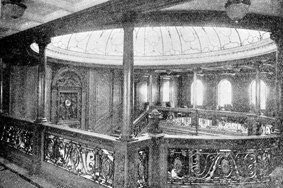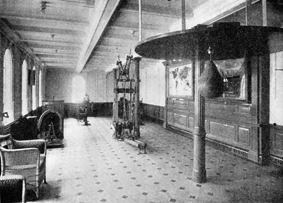Greatest Ship Ever Built

The Titanic was 888 ½ feet long, or about four city blocks, and was 5,000 tons bigger than a battleship.
The registered tonnage was 45,000, and the displacement tonnage 66,000. She was capable of carrying 2,500 passengers and a crew of 860.
The largest plates in the hull were 36 feet long, weighing 4 1/2 tons each, and the largest steel beam being 4 tons.
Like her sister ship, the Olympic, the Titanic was a four funneled vessel and had eleven decks. The distance from the keel to the top of the funnels was 175 feet. She had an average speed of 21 knots.
The steamship was divided into numerous compartments, separated by fifteen bulkheads. She was equipped with a gymnasium, swimming pool, hospital (with operating room), grill & palm garden and even had its own newspaper which was printed daily.
The rudder, which was operated electrically, weighed 100 tons, the anchors 15 1/2 each, the center (turbine) propeller 22 tons, and each of the two “wing” propellers 38 tons each. The after “boss-arms,” from which were suspended the three propeller shafts, tipped the scales at 73 1/2 tons, and the forward “boss-arms'” at 45 tons.
Each link in the anchor chains weighed 175 pounds. There were more than 2,000 portholes and windows to light the public rooms and passenger cabins.
Nothing was left to chance in the construction of the Titanic. Three million rivets (weighing 1,200 tons) held the solid plates of steel together. To insure stability in binding the heavy plates in the double bottom, half a million rivets, weighing about 270 tons, were used.
All the plating of the hulls were riveted by hydraulic power, driving seven-ton riveting machines, suspended from traveling cranes. The double bottom extended the full length of the vessel, varying from 5 feet 3 inches to 6 feet 3 inches in depth, which added strength to the hull.
Luxurious Cabins

Not only was the Titanic the largest steamship afloat but it was the most luxurious. Elaborately furnished cabins opened onto her eleven decks, and some of those decks were reserved as private promenades. One of those suites was sold for $4,350 for the boat’s maiden and only voyage. Similar suites, without the private promenade decks, sold for $2,300.
The Titanic differed in some respects from her sister ship. The Olympic had a lower promenade deck, but in the Titanic’s case, the staterooms were brought out flush with the outside of the superstructure, and the rooms themselves were much larger. The sitting rooms of some of the suites on this deck were 15×15 feet.
The restaurant was much larger than that of the Olympic and it had a novelty in the shape of a private promenade deck on the starboard side, to be used exclusively by its patrons. Adjoining it was a reception room where hosts and hostesses could meet their guests.
Two private promenades were connected with the two most luxurious suites on the ship. The suites were situated about amidships, one on either side of the vessel, and each was about 50 feet long. One of the suites comprised a sitting room, two bedrooms, and a bath.
These private promenades were expensive, costing something like $40 a square foot for a 6-day journey and were the most expensive transatlantic accommodation to be offered.
The Engine Room

The engine room was divided into two sections, one given to the reciprocating engines and the other to the turbines. There were two sets of reciprocating kind, one working each of the wing propellers through a four-cylinder triple expansion, direct-acting inverted engine. each set could generate 15,000 indicated horse-power at 75 revolutions a minute.
The Parsons type turbine takes steam from the reciprocating engines, and by developing a horsepower of 16,000 at 165 revolutions a minute works the third of the ship’s propellers, the one directly under the rudder. Of the four funnels of the vessel three were connected with the engine room, and the fourth or after funnel for ventilating the ship, including the gallery.
Practically all of the space on the Titanic below the upper deck was occupied by steam- generating plant, coal bunkers and propelling machinery. Eight of the fifteen watertight compartments contained the mechanical part of the vessel. There were, for instance, the twenty-four double end and five single end boilers, each 16ft 9′ in diameter, the larger 20ft long and the smaller 11ft 9′ long. The larger boilers had six fires under each of them and the smaller three furnaces. Coal was stored in bunker space along the side of the ship between the lower and middle decks and was first shipped from there into bunkers running all the way across the vessel into the lowest part. From there the stokers handed it into the furnaces. For information about a fire in the bunker, space click here to Titanic Incidents.
Refrigerating Plant
One of the most interesting features of the vessel was the refrigerating plant, which comprised a huge ice-making and refrigerating machine and a number of provision rooms on the after part of the lower and orlop decks. There were separate cold rooms for beef, mutton, poultry, game, fish, vegetables, fruit, butter, bacon, cheese, flowers, mineral water, wine, spirits, and champagne, all maintained at different temperatures most suitable to each. Perishable freight had a compartment of its own, also chilled by the plant.
